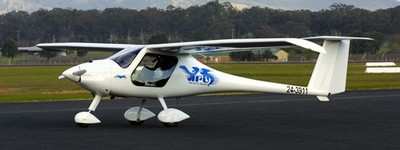Wed, Jul 06, 2011
"Double Podium" For Sinus 912 And Virus SW 100
In the recently-completed Paris-Madrid Green Air Challenge,
Pipistrel aircraft finished first and third in a contest which
places a premium on efficiency.

Pipistrel Sinus 912
The Sinus 912 is an ultra-long-range motorglider, which
won the FAI World Championship in 2001, and took the vice-champion
title in 2005. It accomplished the the first solo,
unassisted, Around the World Flight in the FAI sub 500 kg class in
2004.
Virus SW 80/100 is Pipistrel's flagship, which won both NASA
Centennial Challenges, the PAV in 2007 and GAT Challenge in 2008 as
"the world's best and most fuel efficient light aircraft." The
Virus SW 80/100 is the most economic high speed 2-seat cruiser and
definitely the fastest high-wing aeroplane in its category. Made
from state-of-the-art composite materials it is lightweight, robust
and features an has unprecedented useful payload of more than 660
lbs when flown in the LSA category. Virus SW 80/100 fully conforms
ultralight/microlight category rules, including the stall speed of
40 mph and excellent low speed handling.

Pipistrel Virus
The Paris-Madrid 2011 efficiency race celebrates the 100th
anniversary of the first Morane-Saulier race between Paris and
Madrid back in 2011. Just like the original event, the 2011 race,
named Green Air Challenge, promotes the "conception of innovative
aircraft that are superior from the aerodynamic, engine and
structural point of view".
Sinus 912 (registration F-JRZQ) piloted by Michail Anastatiou,
won the race by a large margin. Virus SW 100 (registration F-JSER)
piloted by Pierre Cormi took third place. Each team had to fly the
distance between Paris and Madrid in several legs, totalling
663 nm as quickly and efficiently as possible, while performing a
noise emission test half-way through the race. Criteria for the
calculation of the final result included: Speed, Payload
Capability, Fuel Consumption, Range distance, Noise Emissions and
Safety Features.

The company extends congratulations to the winning pilots on
these fantastic achievements and extend our compliments to the race
organisers for their green flight initiative.
More News
Touchdown Zone Lighting Two rows of transverse light bars located symmetrically about the runway centerline normally at 100 foot intervals. The basic system extends 3,000 feet alon>[...]
“Discovery and innovation are central to our mission at Virgin Galactic. We’re excited to build on our successful record of facilitating scientific experiments in subor>[...]
"We are reaching out to you today on behalf of the Popular Rotorcraft Association because we need your help. We are dangerously close to losing a critical resource that if lost, wi>[...]
UAS Traffic Management (UTM) The unmanned aircraft traffic management ecosystem that will allow multiple low altitude BVLOS operations and which is separate from, but complementary>[...]
Aero Linx: Society of Aviation and Flight Educators (SAFE) SAFE is a member-oriented organization of aviation educators fostering professionalism and excellence in aviation through>[...]
 ANN's Daily Aero-Term (05.02.24): Touchdown Zone Lighting
ANN's Daily Aero-Term (05.02.24): Touchdown Zone Lighting Aero-News: Quote of the Day (05.02.24)
Aero-News: Quote of the Day (05.02.24) Aero-News: Quote of the Day (05.03.24)
Aero-News: Quote of the Day (05.03.24) ANN's Daily Aero-Term (05.03.24): UAS Traffic Management (UTM)
ANN's Daily Aero-Term (05.03.24): UAS Traffic Management (UTM) ANN's Daily Aero-Linx (05.03.24)
ANN's Daily Aero-Linx (05.03.24)





